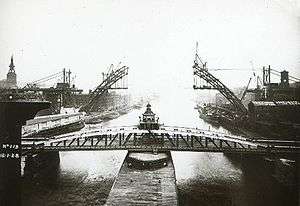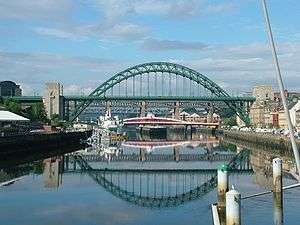Tyne Bridge
| Tyne Bridge | |
|---|---|
|
Tyne Bridge looking towards the modern Sage Gateshead with the now moved Tuxedo Princess moored below. The banner is advertising the 2006 Great North Run | |
| Coordinates | 54°58′05″N 1°36′22″W / 54.968°N 1.606°WCoordinates: 54°58′05″N 1°36′22″W / 54.968°N 1.606°W |
| Carries |
A167 road Motor vehicles Cyclists Pedestrians |
| Crosses | River Tyne |
| Locale | Newcastle upon Tyne and Gateshead, England |
| Characteristics | |
| Design | Through arch bridge |
| Total length | 389 metres (1,276 ft) |
| Width | 17 metres (56 ft) |
| Longest span | 161.8 metres (531 ft) |
| Clearance below | 26 metres (85 ft) |
| History | |
| Construction begin | August 1925 |
| Construction end | 25 February 1928 |
| Opened | 10 October 1928 |
 | |
The Tyne Bridge is a through arch bridge over the River Tyne in North East England, linking Newcastle upon Tyne and Gateshead. The Bridge was designed by the engineering firm Mott, Hay and Anderson,[1] who later designed the Forth Road Bridge, and was built by Dorman Long and Co. of Middlesbrough.[2] The bridge was officially opened on 10 October 1928 by King George V and has since become a defining symbol of Tyneside. It is ranked as the tenth tallest structure in the city.
History of construction


The earliest bridge across the Tyne, Pons Aelius, was built by the Romans near the location of the present Tyne Bridge. Built around 122,[3] it fell into disrepair. The next bridge built was one of stone in 1270. After 500 years, this was destroyed by the great flood of 1771. In 1781, a new stone bridge across the Tyne was completed. Increased shipping activity led to the stone bridge being removed in 1866 to make way for construction of the present Swing Bridge, which opened in 1876.
Work started in August 1925 with Dorman Long acting as the building contractors. Despite the dangers of the building work, only one worker, Nathaniel Collins, a father of four and a local scaffolder from South Shields, died in the building of this structure.[4]
The Tyne Bridge was designed by Mott, Hay and Anderson, comparably to their Sydney Harbour Bridge version.[1] The bridge was completed on 25 February 1928, and officially opened on 10 October by King George V and Queen Mary, who were the first to use the roadway, travelling in their Ascot landau. The opening ceremony was attended by 20,000 schoolchildren who had been given the day off. Movietone news recorded the speech given by the King.[5]
The Tyne Bridge's towers were built of Cornish granite and were designed by local architect Robert Burns Dick[1] as warehouses with five storeys. But, the inner floors of the warehouses in the bridge's towers were not completed and, as a result, the storage areas were never used. Lifts for passengers and goods were built in the towers to provide access to the Quayside; they are no longer in use.[6]
The bridge's design uses a parabolic arch.[7]
The bridge was originally painted green with special paint made by J. Dampney Co. of Gateshead. The same colours were used to paint the bridge in 2000.[8] The bridge spans 531 feet (162 m) and the road deck is 84 feet (26 m) above the river level.

| Total length (includes approaches) | 389 metres (1,276 ft) |
| Length of main arch span (pier to pier) | 161.8 metres (531 ft) |
| Rise of arch (above pins) | 55 metres (180 ft) |
| Clear height (above high water level) | 26 metres (85 ft) |
| Total height (above high water level) | 59 metres (194 ft) |
| Width (bridge) | 17.08 metres (56.0 ft) |
| Width (approaches) | 24 metres (79 ft) |
| Total weight of steelwork (arch only) | 3,556 tonnes |
| Total weight of steelwork (including approaches) | 7,112 tonnes |
| Total number of rivets (including approaches) | 777,124 |
History of operations



Tram lines were built into the Tyne Bridge structure and ready for immediate use after the opening ceremony in October 1928. Tram car No. 289 was the last Newcastle tram to run into Gateshead over the Tyne Bridge on Sunday 5 March 1950 at approximately 10.55 pm. The tram lines were subsequently removed, although some vestiges of these remain such as redundant fixings for overhead power lines.
Golden jubilee celebrations were held on 10 October 1978, when 1,000 balloons were released into the sky above the river to celebrate the anniversary of the Tyne Bridge. To mark the occasion, a cavalcade of vintage vehicles and a procession of people in period dress stopped traffic, re-creating the opening ceremony when King George V declared the bridge open in 1928.
Upon opening, the bridge carried the A1 road. Following the opening of the Tyne Tunnel in 1967, however, the A1 was diverted to the East and the road became the A6127. Following the construction of the Newcastle Western Bypass, the A1 moved again. The bridge was redesignated as the A167, which it remains today.
In 2012, the largest Olympic rings in the UK were erected on the bridge. The rings were manufactured by commercial signage specialists Signmaster ED Ltd of Kelso. The rings were over 25 metres wide and 12 metres tall and weighed in excess of 4000 kg. This was in preparation for Newcastle hosting the Olympic football tournament, and the Olympic torch relay, in which Bear Grylls zipwired from the top of the arch, to Gateshead quayside.[9]
On 28 June 2012, a large lightning bolt struck the Tyne Bridge. It lit up the roads as the sky was very dark. The bolt, part of a super-cell thunderstorm, came with heavy rain – a month's worth of rainfall in just 2 hours – causing flash flooding on Tyneside.[10]
In 2015 Newcastle upon Tyne was a host city for the Rugby World Cup.[11] Three matches were played at St James Park, the home of Newcastle United Football Club.[12] In recognition, a large illuminated sign was erected on Tyne Bridge.[13]
Kittiwake colony
The bridge and nearby structures are used as a nesting site by a colony of around 700 pairs of black-legged kittiwakes, the furthest inland in the world. The colony featured in the BBC's Springwatch programme in 2010.[14] Several groups, including the Natural History Society of Northumbria and local Wildlife Trusts, formed a "Tyne Kittiwake Partnership" to safeguard the colony.[15] A proposal for a tower to be built as an alternative nesting site was made in 2011,[16] and in November 2015 a neighbouring hotel submitted a planning application for measures to discourage the birds.[17]
References
- 1 2 3 Elwall, Robert. "Tyne Bridge". British Architectural Library. Retrieved 14 July 2014.
- ↑ "Dorman Long Historical Information". dormanlongtechnology.com. Retrieved 14 July 2014.
- ↑ "Fact File:The Roman Tyne Bridge". twmuseum.org.uk. Retrieved 24 November 2014.
- ↑ Butcher, Joanne (1 March 2013). "85 years of the Tyne Bridge". ChronicleLive. Retrieved 14 July 2014.
- ↑ Butcher, Joanne (26 February 2013). "Bridge spans the generations". chroniclelive.co.uk. Retrieved 24 November 2014.
- ↑ "The Tyne Bridge". Bridges on the Tyne. 2006. Retrieved 13 November 2011.
- ↑ "Tyne Bridge". BBC Inside Out. 24 September 2014. Retrieved 25 April 2016.
- ↑ Butcher, Joanne (2013). "85 years of the Tyne Bridge: Crossing of the great divide". Chronicle Live. Retrieved 20 October 2016.
- ↑ "Olympic rings launched on Tyne Bridge". Retrieved 16 June 2012.
- ↑ Hough, Andrew (29 June 2012). "Weather: record 110,000 lightning bolts strike during 'superstorms'". The Telegraph. Retrieved 20 October 2016.
- ↑ "Host Cities: Newcastle". Rugby World Cup. 2015. Retrieved 8 December 2015.
- ↑ "St James' Park". Rugby World Cup. 2015. Retrieved 8 December 2015.
- ↑ Davies, Katie (18 February 2015). "Rugby World Cup 2015: Tyne Bridge sign to be replaced with Great North Run advert". Newcastle Chronicle. Retrieved 8 December 2015.
- ↑ "Tynesiders". BBC Springwatch. 19 May 2010. Retrieved 8 December 2015.
- ↑ "Tyne Kittiwakes Partnership". Natural History Society of Northumbria. 2016. Retrieved 8 December 2015.
- ↑ Wainwright, Martin (17 May 2011). "Newcastle in a flap over urban kittiwake colony". The Guardian. Retrieved 8 December 2015.
- ↑ "Installation of bird netting, angled sill plates and avishock system to tower – Tyne Bridge Tower Lombard Street Newcastle upon Tyne". Newcastle City Council. 9 November 2015. Retrieved 8 December 2015.
Further reading
- Addyman, J. and Fawcett, B. The High Level Bridge and Newcastle Central Station: 150 Years Across the Tyne. By the North Eastern Railway Association for the High Level Bridge. 1999. ISBN 1-873513-28-3.
- Linsley, S. Spanning the Tyne: Building of the Tyne Bridge, 1925-28. Newcastle Libraries and Information Service, Newcastle City Council. 1998. ISBN 1-85795-009-7.
- Manders, F. & Potts, R. Crossing the Tyne. Tyne Bridge Publishing. 2001. ISBN 1-85795-121-2.
External links
| Wikimedia Commons has media related to Tyne Bridge. |
- Databases: Bridges On The Tyne, Engineering Timelines, and Tyne Bridge at Structurae
- Articles: BBC Inside Out - Tyne Bridge
- Map sources for Tyne Bridge.
- Images
- Historic photographs: Dorman Long collection, Pictures of Gateshead
- Aerial photographs: Britain from Above - aerial views of the bridge under construction and later in the 1930s, from the Aerofilms archive of English Heritage
- Photographs of Tyne Bridges: Peter Loud
- Video: BBC - Nation on Film
| Next crossing upstream | River Tyne | Next crossing downstream |
| Swing Bridge | Tyne Bridge Grid reference: NZ253637 |
Gateshead Millennium Bridge (foot and cycle) |
